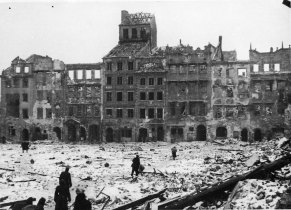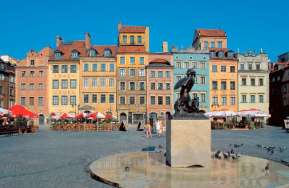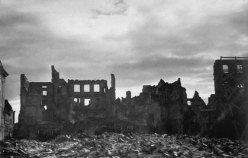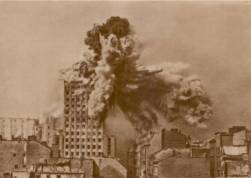Authrs: Jolanta Kowalewska, Adam Zadworny, Alex Kuehl
Source: Gazeta Wyborcza
Translation from Polish for this blog: MoPoPressReview
* * *
A for pre-war 200m house with 5,500 metres square of land in a tiny German village of Hochenseldoff, several kilometres away from the Polish-German border, costed Piotr Wychadończuk 50,000 zł (nearly $25,000). ‘I can’t afford an appartment in Poland. In Szczecin metropolis this money would buy me a garage’, he says. ‘Besides, my wife and I are having twins and we need more Lebensraum’.
‘Eurosceptics from right-wing parties were threatening with the Germans coming and buying our land when we join the EU – and it’s the total opposite’, laughs Bartłomiej Sochański, a barrister from Szczecin and honorary consul of Germany. Even before the Schengen Agreement came to effect in Poland, Poles had been settling on the other side of the Oder river.
Garden fire only with Fire Department permission
‘To live in Germany you need: a letter box, a blue barrel and a current account in a German bank’, Jacek reveals basic rules of living behind the border. He’s 31, owns a two-bedroom flat in Szczecin and a stationary selling business. In spring 2007 he bought 3 hectares of German land in Radekow together with a former firefighters’ station. He’ll move in this spring with his wife, 4-year-old son and parents. A shiny letterbox is already hanging on the fence.
– ‘That’s the first thing you have to get’, says Jacek, ‘in order to receive official letters from institutions. ‘Thank goodness first class letters in Germany don’t need to be delivered in person, therefore I never have to go to the post office’.
– And what do you need the blue barrel for?
– ‘German thrift. They all use rain water for their gardens rather then a hose.
– And an account?
– ‘I hired an architect, and it turned out he didn’t accept cash’.
Jacek shows me around other houses purchased by the Polish. Each of them is equipped with solar power screen. Solar energy heats houses and water. Only dog houses don’t have them. And Jacek’s place. It’s a long one-storey building, which soon will be demolished to make way for Jacek’s new semi-detached.
– How will you handle the commute?
– ‘Oh, it’ll be easier then now. Even a taxi can drop me here after a night out in Szczecin’.
– And how do you communicate with German civil servants?
– ‘I don’t speak any German at all’.
– Really?
– ‘The lady at the Department of Housing was surprised too’.
Jacek wonders whether to register his son to a German pre-school. So far his little son practices his language skills when he meets his neighbours. It’s an elderly couple, who are pleased to have new new people in the area. They brought their home-made jam for Jacek’s family to try.
– ‘Friends were warning me about some German neo-fascist parties. I haven’t seen anyone like that yet’.
– What surprised you here the most?
– ‘That you can’t make a fire in your own garden. You need a permission from Fire Department and you need to pay somewhat 10 euro’ for that.
Roe-deer feeding classes
Joanna and Tadeusz Czapscy moved to a forrester’s cottage near Tantow, which they bought together with three hectares of land, ten roe-deer, a bat, and a pond full with crucian carp.
Their estate lies around 25km from the Szczecin city centre. In Poland Mr and Mrs Czapski lived in one of the communist blocks of flats. ‘Commute from that flat and from Tantow takes the same amount of time’, Mr Czapski explains. ‘After Schengen, I pop into my car and drive. Keine grenzen!’.
The price was right as well. 90,000 euro.
Joanna and Tadeusz’s cottage looks charming with wooden fence and hedge. Pasturage for roe-deer is visible from a distance. Deer have 2 hectars of forrest for themselves. Only during the winter they need to be fed.
‘When I saw these roe-deer I knew it’s aither this house or none for me’ recalls Joanna. ‘Previous owner told us when they eat all the nettle, it’s the time to start feeding.
What surprised them the most, was the fact that if they wanted to keep the roe-deer they had to complete a course on how to take care of wild animals.
Joanna walks around the house repeating: “bread – brot”, “buns – brotchen”, “butter – butter”. – We’ll be doing the shopping on the Polish side, as it’s still cheaper. But when we run out of something I have to know the basic words – she says.
A neighbour is busy with something behind the fence. A German man in his thirties.
– ‘When my lawn-mower broke down, be was here to lend me his within seconds. That’s how we met. He’s a really nic chap’.
We have level pavements
– ‘This house was four times cheaper, then a similar house in a Polish village. Only the pavement here is level, there is street light, and it’s generally safe’, explains Bartek Wójcik.
House bult in 1865 roku is around 200 metre sq. on a 1000 metre sq patch. 23,000 Euro. For Poles a real Bargain!
Bartek and his wife Danka are running “OFFicyna” association in Szczecin, which is renowned organiser for cultural events like Szczecin film festivals. Last year they decided to get on the property ladder. They tried to buy a flat in Szczecin, or a house in the country. Too expensive. They decided to choose Germany.
Their haouse stands on a hill, the driveway covered with cobblestone. Spruce and thuja trees grow on sides. Red barn with massive door stands graciously in the middle.They’re discovering the rules of life in the village of Schwennentz. What surprised them the most was German’s thrift. For instance in autumn the whole village prepares one joint order for heating oil. Because it’s cheaper that way.
‘Before Schengen it took us 20 minutes to commute to work in Szczecin, and since Schengen it feels as if we lived in one of the city districts’.
Little towns becoming Polish
‘Poles usually seek houses between 100 and 200 metre sq., not further than 30 kilometres from the border’, says Mariola Dadun, who together with her German husband run a real estate agency serving both sides of the border.
It is estimated that around 2000 Polish families purchased houses in Meklemburg and Brandenburg recently.
Penkun, Gartz and Loecknitz are the towns with largest Polish population – around 200 live in the latter. A Polish-German middle school has been open in Loecknitz for several years. One third of students, around 160, are Poles. A businessman from Szczecin launches a new Petrol station in Loecknitz. Polish company builds a new residential development. One of towns hotel is town-house converted by a Polish couple. Hair-dos in Locknitz are also Polish-made. A Polish businesswoman opened there a hair salon.
It is amazing how the West European borders, previously both so desired and hated, are simply disappearing. Just like that.
* * *
—
If you enjoyed this post why not visit Polandian, a collaborative blog on Poland.





LAST 5 COMMENTS